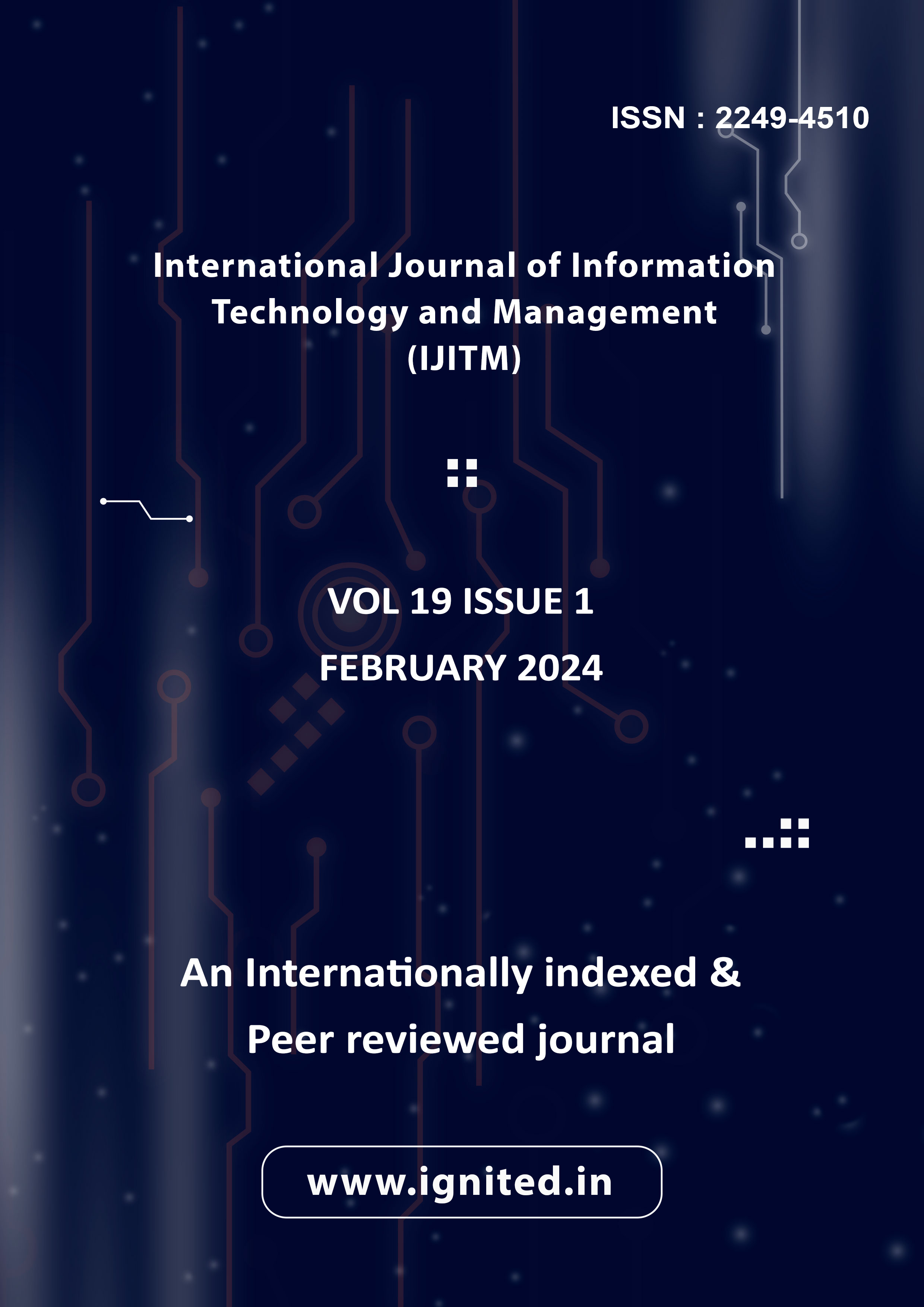Organizational Strategies and Policies for Implementing Emerging Cybersecurity Technologies
Main Article Content
Authors
Abstract
This research uses quantitative data analysis and a qualitative exploratory method to examine how organisations embrace innovative cybersecurity solutions. The study looks at organisational policies, governance frameworks, strategic approaches, and cultural aspects that affect technology adoption using a stratified random sample technique. Structured questionnaires & feedback forms provided the data, which were then analysed using AMOS and SPSS statistical software with an emphasis on structural equation modelling (SEM) to investigate correlations between variables. A supportive organisational culture positively correlates with technology adoption (χ² = 41.179, df = 31, p < 0.001, CMIN/DF = 1.328, RMSEA = 0.034), and organisations with a proactive strategic approach were more successful in implementing cybersecurity technologies (χ² = 50.400, df = 26, p < 0.001, CMIN/DF = 1.938, RMSEA = 0.058). The research also finds that while comprehensive policies influence adoption via efficient training programs, employee involvement completely mediates the association between organisational culture and technology adoption. These findings demonstrate how crucial culture, employee participation, strategic planning, and training are to the successful integration of cybersecurity technology.
Downloads
Article Details
Section
References
- A Mishra, YI Alzoubi, MJ Anwar, A. G. (2022). Attributes impacting cybersecurity policy development: An evidence from seven nations.
- Ahmad, A., Desouza, K. C., Maynard, S. B., Naseer, H., & Baskerville, R. L. (2020). How integration of cyber security management and incident response enables organizational learning. Journal of the Association for Information Science and Technology, 71(8), 939–953. https://doi.org/10.1002/asi.24311
- Al-alawi, P. A. I. (2020). The Significance of Cybersecurity System in Helping Managing Risk in Banking and Financial Sector. Journal of Xidian University, 14(7). https://doi.org/10.37896/jxu14.7/174
- AlDaajeh, S., Saleous, H., Alrabaee, S., Barka, E., Breitinger, F., & Raymond Choo, K. K. (2022). The role of national cybersecurity strategies on the improvement of cybersecurity education. Computers and Security, 119(May). https://doi.org/10.1016/j.cose.2022.102754
- Ansari, M. F. (2022). An Effective Cybersecurity Awareness Training Model: First Defense of an Organizational Security Strategy. International Research Journal of Engineering and Technology (IRJET), 9(4), 1–6.
- Blomsma, F., Pieroni, M., Kravchenko, M., Pigosso, D. C. A., Hildenbrand, J., Kristinsdottir, A. R., Kristoffersen, E., Shabazi, S., Nielsen, K. D., Jönbrink, A. K., Li, J., Wiik, C., & McAloone, T. C. (2019). Developing a circular strategies framework for manufacturing companies to support circular economy-oriented innovation. Journal of Cleaner Production, 241, 118271. https://doi.org/10.1016/j.jclepro.2019.118271
- Camacho, N. G. (2024). The Role of AI in Cybersecurity: Addressing Threats in the Digital Age. Journal of Artificial Intelligence General Science (JAIGS) ISSN:3006-4023, 3(1), 143–154. https://doi.org/10.60087/jaigs.v3i1.75
- Fuertes, G., Alfaro, M., Vargas, M., Gutierrez, S., Ternero, R., & Sabattin, J. (2020). Conceptual Framework for the Strategic Management: A Literature Review - Descriptive. Journal of Engineering (United Kingdom), 2020. https://doi.org/10.1155/2020/6253013
- Georgiadou, A., Mouzakitis, S., Bounas, K., & Askounis, D. (2022). A Cyber-Security Culture Framework for Assessing Organization Readiness. Journal of Computer Information Systems, 62(3), 452–462. https://doi.org/10.1080/08874417.2020.1845583
- Ghelani, D. (2022). Diptiben Ghelani. Cyber Security, Cyber Threats, Implications and Future Perspectives. American Journal of Science, Engineering and Technology, 3(6), 12–19. https://doi.org/10.11648/j.XXXX.2022XXXX.XX
- Haroun, M. H., Gohar, N., & Hanna, H. A. (2020). TOE Model: Adoption of Block Chain. The Business and Management Review, 11(01). https://doi.org/10.24052/bmr/v11nu01/art-19
- Holovkin, B. M., Tavolzhanskyi, O. V., & Lysodyed, O. V. (2021). Corruption as a Cybersecurity Threat in the New World Order. Connections, 20(2), 75–87. https://doi.org/10.11610/Connections.20.2.07
- Huang, K., & Pearlson, K. (2019). For what technology can’t fix: Building a model of organizational cybersecurity culture. Proceedings of the Annual Hawaii International Conference on System Sciences, 2019-January, 6398–6407. https://doi.org/10.24251/hicss.2019.769
- Janssen, M., Weerakkody, V., Ismagilova, E., Sivarajah, U., & Irani, Z. (2020). A framework for analysing blockchain technology adoption: Integrating institutional, market and technical factors. International Journal of Information Management, 50, 302–309. https://doi.org/10.1016/j.ijinfomgt.2019.08.012
- khalil, M. I. . & A.-R. M. (2023). Advanced Cybersecurity Measures in IT Service Operations and Their Crucial Role in Safeguarding Enterprise Data in a Connected World. Eigenpub Review of Science and Technology, 7(1), 138–158.
- Kumar, S., Biswas, B., Bhatia, M. S., & Dora, M. (2021). Antecedents for enhanced level of cyber-security in organisations. Journal of Enterprise Information Management, 34(6), 1597–1629. https://doi.org/10.1108/JEIM-06-2020-0240
- Matter, D. I. (2021). Cybersecurity Capacity Building. 9, 190–190. https://doi.org/10.1007/978-3-319-95873-6_300023
- Mijwil, M. M., Filali, Y., Aljanabi, M., Bounabi, M., & Al-Shahwani, H. (2023). The Purpose of Cybersecurity Governance in the Digital Transformation of Public Services and Protecting the Digital Environment. Mesopotamian Journal of CyberSecurity, 2023, 1–6. https://doi.org/10.58496/MJCS/2023/001
- Montewka, J., Wróbel, K., Mąka, M., Nozdrzykowski, Ł., & Banaś, P. (2020). Quantitative model evaluating the effect of novel decision support tool on the probability of ship-ship accident. Proceedings of the 30th European Safety and Reliability Conference and the 15th Probabilistic Safety Assessment and Management Conference, October. https://doi.org/10.3850/978-981-11-2724-3
- Rajan, R., Rana, N. P., Parameswar, N., Dhir, S., Sushil, & Dwivedi, Y. K. (2021). Developing a modified total interpretive structural model (M-TISM) for organizational strategic cybersecurity management. Technological Forecasting and Social Change, 170. https://doi.org/10.1016/j.techfore.2021.120872
- Sallos, M. P., Garcia-Perez, A., Bedford, D., & Orlando, B. (2019). Strategy and organisational cybersecurity: a knowledge-problem perspective. Journal of Intellectual Capital, 20(4), 581–597. https://doi.org/10.1108/JIC-03-2019-0041
- Senarak, C. (2021). Port cybersecurity and threat: A structural model for prevention and policy development. Asian Journal of Shipping and Logistics, 37(1), 20–36. https://doi.org/10.1016/j.ajsl.2020.05.001
- Shah, V. (2021). Revista Española de Documentación Científica Machine Learning Algorithms for Cybersecurity: Detecting and Preventing Threats. 04, 42–66. https://doi.org/10.5281/zenodo.10779509
- Tondeur, J., Scherer, R., Baran, E., Siddiq, F., Valtonen, T., & Sointu, E. (2019). Teacher educators as gatekeepers: Preparing the next generation of teachers for technology integration in education. British Journal of Educational Technology, 50(3), 1189–1209. https://doi.org/10.1111/bjet.12748
- Yarovenko, H., Kuzmenko, O., & Stumpo, M. (2020). Strategy for Determining Country Ranking by Level of Cybersecurity. Financial Markets, Institutions and Risks, 4(3), 124–137. https://doi.org/10.21272/fmir.4(3).124-137.2020

